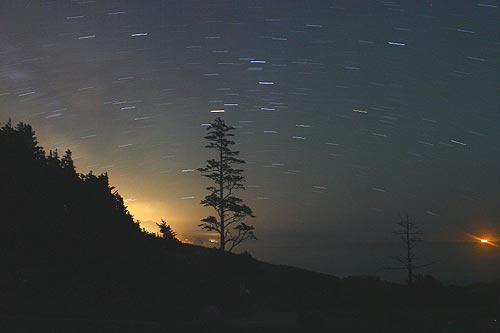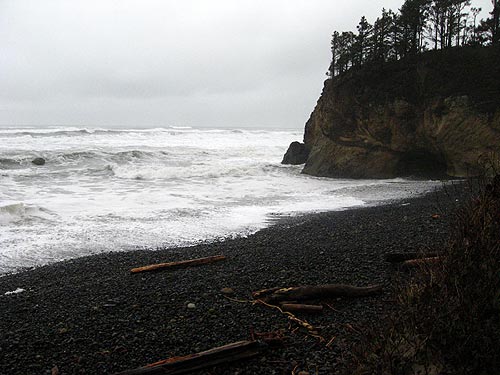Like Day and Night on Oregon Coast: Shades of Cannon Beach
Published 11//30/2011

(Cannon Beach, Oregon) – It's amazing the different faces sported by the north Oregon coast destination spot of Cannon Beach. From season to season, the same beach will look drastically different. Sand levels rise and fall, things wash up that weren't there before, and sometimes something familiar is even taken away.
At other times, however, if you really want a visual shocker, check out the differences between night and day.
A spectacular case in point can be found at Ecola State Park, a major photographic hotspot for a century, and a stopping point for the famed Lewis & Clark expedition 100 years before that. Above, at the end of the day, the place glows in a variety of shades of reds and violets, accentuated by that landmark tree.

The same scene after dark, on an early summer night, reveals an amazing array of stars, while the glow of the town is the brightest light available. Although a fishing boat or two are also vying for attention.

 At the very southern end of town, beyond the Tolovana area, where the streets take on names from other southern coast counties and towns, these often run straight into the beach itself. One of these accesses features a beautiful chunk of rock that can sometimes yield tide pool life. At night, atmospheric gasses take over, seen only by the camera but not by the human eye, and the world takes on ethereal colors.
At the very southern end of town, beyond the Tolovana area, where the streets take on names from other southern coast counties and towns, these often run straight into the beach itself. One of these accesses features a beautiful chunk of rock that can sometimes yield tide pool life. At night, atmospheric gasses take over, seen only by the camera but not by the human eye, and the world takes on ethereal colors.
On this particular night, the clouds dominated, but for a while there was a large crack in them, allowing the stars to shine through, which then became enormous, dramatic streaks because of the long period of time such a camera exposure takes.

There is, of course the iconic Haystack Rock, known as one of the most photographed spots in the entire northwest. No look at Cannon Beach would be complete without an examination of it.

At night, it too is an unreal visage. The yellow cast on it is from nearby streetlights. The shutter being open for a few minutes causes the ocean to become a surreal mist. Fishing boats in the distance look like a sunset gone wrong.

More beachy fun is a few miles south of town at Hug Point, where all sorts of surprises await. You first enter via a small path leading down to a rocky chunk of the beach, which then gives way to sand. Unless of course it's high tide - then there's just rocks.

Look at the same place at night, and the colors have drastically changed and the raging tide and its movement are frozen in time, made a hazy, startling blur by the camera. It's now even more evident where the tide stops.

Hug Point goes bonkers when it comes to sand levels. They can move up and down here like crazy over the seasons, and this mushroom-shaped blob of a rock gets not only further revealed, but some years the sand levels get so low you can see the bedrock from which is comes out of.

Check it out during summer, as night has just fallen. That blob is covered by sand and the bedrock is gone. The mist-like ocean comes into play, but the post-dusk light creates a dominant dark blue cast, as the moon tries to get its fair share of attention. The reflections it creates are downright exotic.
Cannon Beach Lodging
Nehalem Bay Lodgings
Manzanita Hotels, Lodging
Three Capes Lodging
Pacific City Hotels, Lodging
Lincoln City Lodging
Depoe Bay Lodging
Newport Lodging
Waldport Lodging
Yachats Lodging
Oregon Coast Vacation Rentals
Oregon Coast Lodging Specials
More About Oregon Coast hotels, lodging.....
More About Oregon Coast Restaurants, Dining.....
LATEST Related Oregon Coast Articles
Yaquina Bay Tree stands in the middle of the road at the park. Newport, Yachats, Lincoln City, Depoe Bay
Oregon Coast Range Highway Gets Emergency Work After Numerous Mishaps
Roadway is being removed to leave gravel as a stop-gap measure. Seaside, Astoria, Cannon Beach, traffic, Manzanita
'Bump' on Highway 26 to Oregon Coast Causing Damage, Hazards. Major Action Taken
ODOT is taking drastic action after it caused crashes, severe car damage. Seaside, Astoria, Cannon Beach, traffic, Manzanita
Volunteers Needed for Garden Near Coos Bay: Help Out Oregon Coast Landmark at...
Inviting everyone to roll up their sleeves and join its Garden Volunteer Days. Coos Bay events, south coast events
Cannon Beach, Oregon Coast Virtual Tour, Maps, Complete Guide
Deep Details: Mileposts, Beach Accesses, Maps, Over 100 pages
Oregon's Extreme Weather This Week Includes Lightning, 28-ft Surf, Hail, Poss...
Into Washington: a chance of severe thunderstorms; high surf on coast, large hail
Rockaway Beach Oregon Coast Weather, Alerts, Current Conditions, Cams, Foreca...
Wave height, buoy cam, data from buoys and ships nearby, wind station
Killer Whales Return to Oregon Coast with More Than 10 Off Depoe Bay
Orcas are back as if on cue, might see them through June. Marine sciences, weather
Back to Oregon Coast
Contact Advertise on BeachConnection.net
All Content, unless otherwise attributed, copyright BeachConnection.net Unauthorized use or publication is not permitted












































